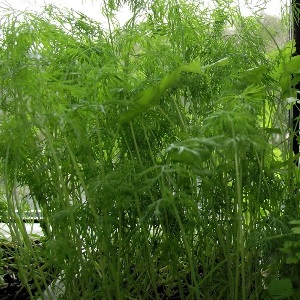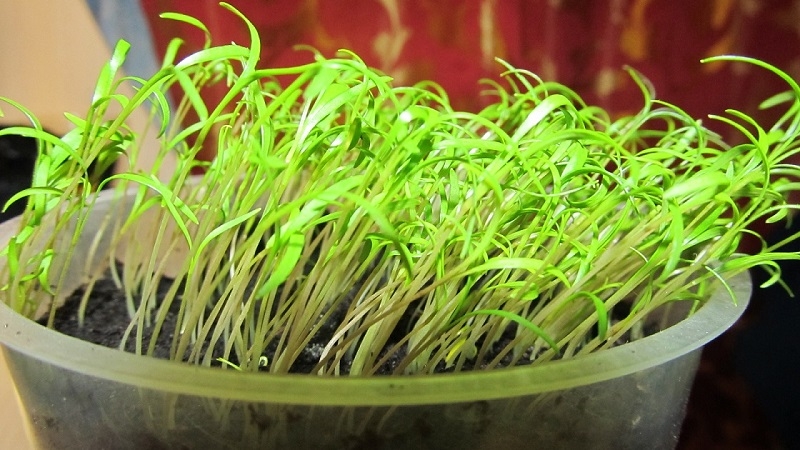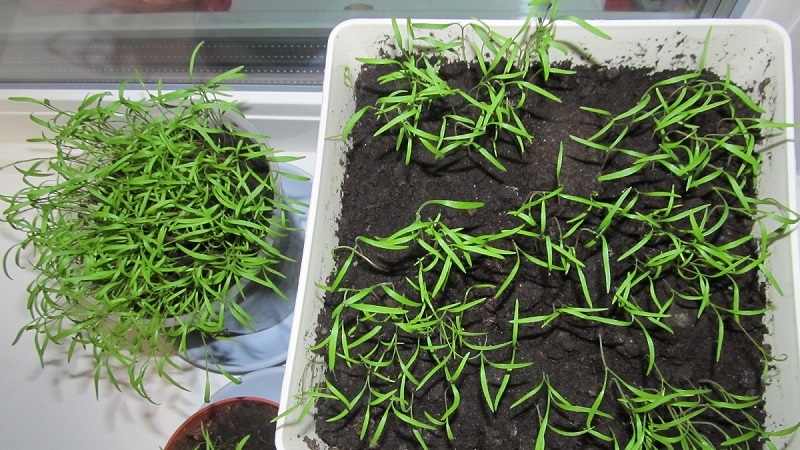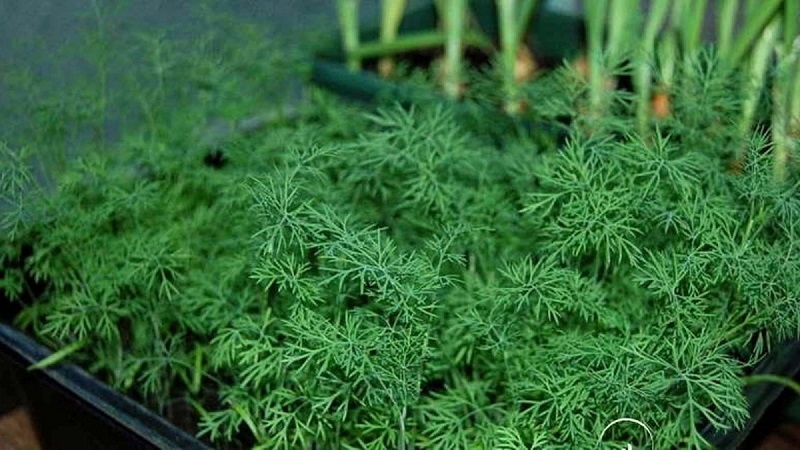How to grow dill on a windowsill in an apartment: the necessary equipment and a step-by-step guide
Experienced gardeners know how to grow dill on a windowsill in an apartment, and they do it successfully. This allows them to enjoy fresh greens at any time of the year. This process is laborious, but exciting, so some housewives have turned it into their hobby.
From the article you will learn which varieties of dill are suitable for home cultivation, how to properly prepare seeds and how to care for plants.
The content of the article
Choosing the right dill variety
Early dill is preferable to grow at home. For quick shoots, it is recommended to choose varieties: Gribovsky, Grenadier, Aurora, Dalny. But we must not forget that they are demanding on the conditions in which they will be kept during growth.
Attention! There is no special variety of dill for growing on the windowsill, so the seeds are selected experimentally.
If you do not control the temperature regime or provide insufficient lighting, the seedlings will begin to stretch upward, and the bright green color will change to a light green hue. This negatively affects the quality of the spice.
Novice gardeners are advised to opt for mid-season varieties. (Richelieu, Lesnogorodsky, Bushy) or later varieties (Kibray, Salute, Alligator).

What is needed to grow dill on a windowsill in an apartment
Dill is an annual plant. The average growth rate is 5 to 8 weeks. The ideal time for planting is March-August. Growing is more difficult during the winter months due to the lack of light.
Container and inventory
Initially, you need to prepare tools and containers. To grow greens in an apartment on a windowsill, you will need the following:
- a pot or other container for earth with a depth of not more than 20 cm;
- special soil for indoor plants;
- water spray (spray bottle);
- additional illumination lamps (best of all fluorescent);
- Dill seeds.
The window in the house is chosen on the side with the most sunlight. If a battery passes under it, you will have to monitor the humidity level and prevent the earth from drying out. It is recommended to sow dill in boxes made of wood or plastic 15-20 cm deep. There should be holes at the bottom of the container through which excess liquid is drained.
You can find out how dill helps with cataracts by this link.
Terms
Plant dill seed possible at any time of the year. The ideal temperature for seedlings is considered to be between 18 and 20 degrees Celsius during the day. It is good if at night the temperature in the room does not exceed 10 degrees Celsius. This will help harden and stretch the seedlings. You can achieve this effect if you take the container out onto a glazed loggia or into a corridor.
Council.To compensate for uneven lighting, the container with seedlings is rotated 180 degrees 2-3 times a day.
Additional lamps above containers are turned on for 12 hours. They are located at a distance of about 50 cm from the tops of the shoots. If the house maintains a temperature of more than 20 degrees Celsius, you will have to illuminate it for 14-15 hours; otherwise, the stems will begin to stretch.
Step by step instructions for growing
It is possible to grow dill at home even in winter. To do this, you need to prepare a place for seedlings, pots for seeds, special soil.Step-by-step instructions will help novice gardeners avoid mistakes that will lead to the death of greenery.
Seed and soil preparation
Before planting herbs at home, you need to prepare the seeds. They should be properly processed, which will protect future seedlings from possible diseases (oversporosis, powdery mildew, fungus, phomosis).
 Seed preparation consists of the following steps:
Seed preparation consists of the following steps:
- Soak the seeds in a solution of potassium permanganate (1 mg of the product is diluted in 100 ml of water) for 20 minutes, after placing it in a gauze bag. Those grains that have surfaced are thrown away, since they are considered dead and will not sprout. After the time has elapsed, the seeds are washed with running water and allowed to dry.
- To activate growth, seeds are additionally soaked in a special solution (Epin, Zircon, Energen).
- The seeds should germinate unfolded on a plate lined with cotton cloth. A glass or bag is placed on top of the container to create a greenhouse effect, and left at room temperature.
- The film is periodically removed (1-2 times a day) and waited for the seeds to hatch. The fabric is additionally moistened.
Dill seeds take a long time to germinate. This is due to the increased content of essential oils in them. You can remove the dense shell if you rinse the seeds before planting for 15-20 minutes with warm water (about 50 degrees). You can also place them in a bag of gauze in a container of water, having previously installed an aquarium compressor in it.
It is best to plant dill seeds in loose, pH neutral soil. To do this, it is recommended to purchase a universal seedling soil, which contains all the necessary nutrients. The substrate can be prepared independently from garden soil, coconut fiber, peat and river sand in a ratio of 2: 1: 1: 1, respectively.
Attention! Suitable for soil disinfection means "Fitosporin" or "Gamair". Another option is to bake it in the oven before planting.
A mixture of vermicompost and coconut fiber in a ratio of 1: 2 is also used. It is important to add here 2 g of superphosphate and wood ash (per 1 liter of substrate). Be sure to additionally prepare drainage (expanded clay).

Sowing
The process of planting dill seeds is as follows:
- drainage (expanded clay) 2-3 cm thick is poured into the selected container;
- earth is poured over it, leaving about 3 cm to the edge of the container;
- the earth is slightly leveled with hands, crushed a little and watered;
- gently sprinkle with earth about 0.5 cm;
- then the soil is moistened with a sprayer;
- the pot is covered with polyethylene or glass, and then put in a dark place with a temperature of about 25 degrees Celsius.
It remains to wait until all the water is absorbed into the ground. After that, they start sowing seeds. If the boxes are long, make them bright and plant seedlings in rows. In a flower pot, it is better to make holes 0.5 cm deep and put 3-5 seeds in them, or evenly scatter the seeds over the surface.
Further care
Until the first bushes begin to grow, caring for future dill is simple: moisten the ground as it dries and air the greenhouse twice a day... If condensation has ceased to collect on the lid of the mini-greenhouse, it means that the earth needs moisture. The first shoots can be expected 10-12 days after planting.
When shoots appear, the seedlings should be moved to a bright place and thinning should be performed. This process is especially important if a bush dill variety was chosen for planting. Weak and densely sprouted shoots are subject to removal. On average, the distance between them should be 3-4 cm.
When dill has two true leaves, the plants are taught to live without a greenhouse. If the variety is whimsical, this is done gradually, daily increasing the airing time by 30 minutes. After 7 days, the greenhouse is completely removed.If the variety is resistant to cold, the film can be removed immediately (it is better to do this in the morning) so that the plant adapts to new conditions during daylight hours.

Features of growing in winter and summer
The main condition for good growth, especially if the planting took place during the winter period, is sufficient lighting. When it is planned to grow a spice in the period from September to February, it is imperative to illuminate it, otherwise the plants will develop poorly, turn yellow or even die.
When planting dill seeds for growing on a windowsill in the spring and summer, containers with seedlings are placed on the window on the south side, in the southwest or southeast direction. It is recommended to highlight seedlings only on cloudy days.
Useful Tips
Water the dill on the windowsill regularly as the soil dries up, using water at room temperature; melted snow is suitable in winter. In the autumn period, the soil is moistened on average 1-2 times a week, and in the summer - daily. If the air in the room is dry, greens are sprayed once a day, then it will be juicy.
In order for the root system to grow well and get stronger quickly, it is necessary to periodically loosen the ground. Do this gently with your fingers or a special small garden rake for indoor flowers. Once every 14 days, the plant should be fed with a complex organic ("Biohumus", "Organic-balance") or mineral ("Juno", "Kemira Lux") fertilizer.
How to make delicious dill sauce, read here.
IN this article you can learn how to use dill for high blood pressure.
Read also how brew and take dill seeds for cough: for adults and children.

Conclusion
For successful cultivation of dill on the windowsill, it is important to choose the right variety, prepare the planting material and soil, and take care of creating a favorable climate in the room where the seedlings will be located.
If all conditions are met, all year round you can enjoy the taste of juicy, fresh greens grown by your own hands.